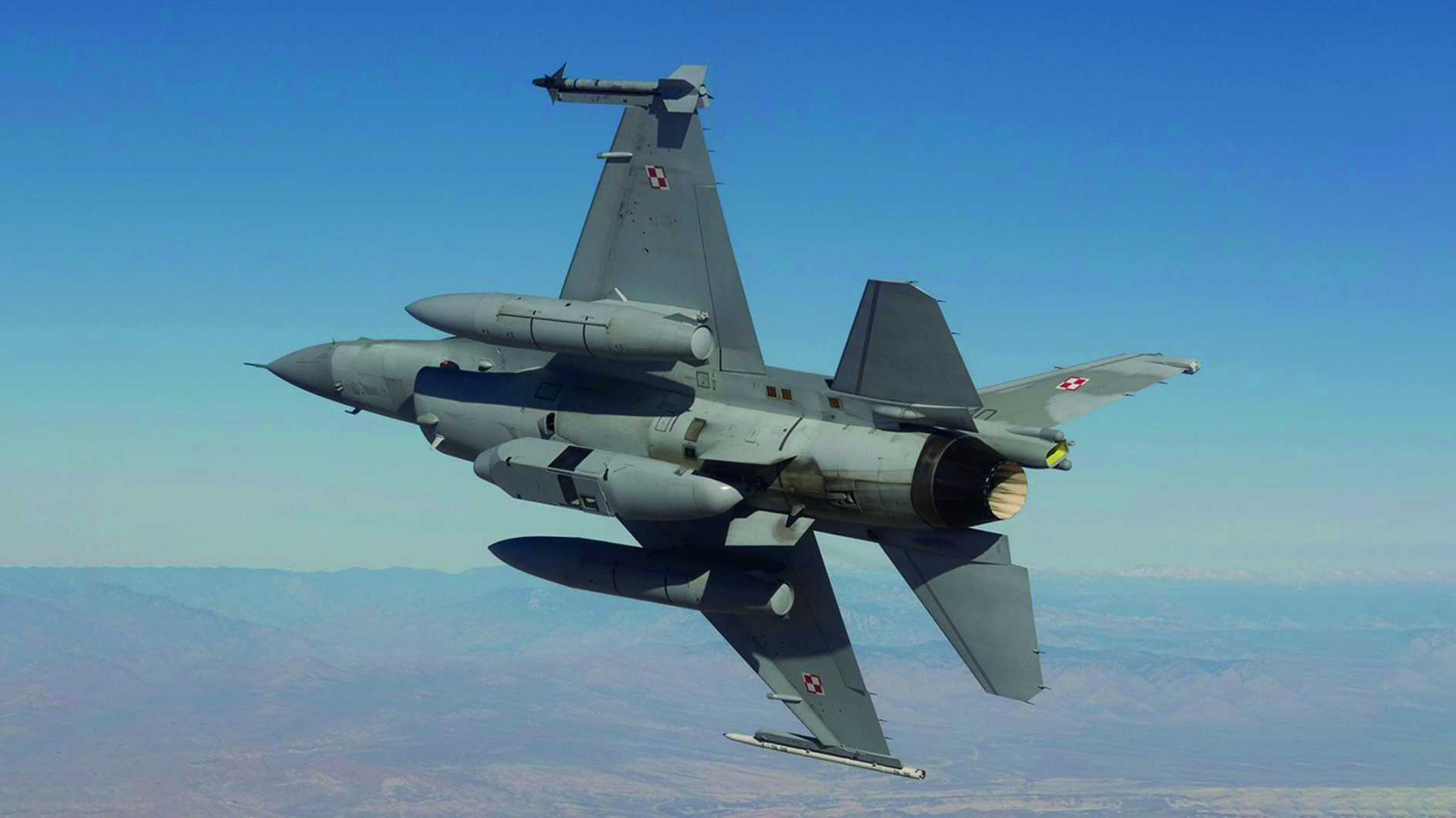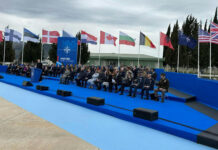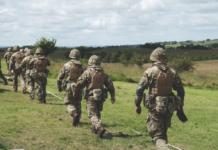The words “underwing pod” cover reconnaissance pods, jamming pods, targeting pods, as well as simpler hardware such as gun pods, multi-round rocket pods, or even the prosaic cargo pods that can carry such unglamorous items such as aircrew luggage during long-range deployments. But it is those pods which exploit advances in modern electronics and electro-optics that provide the greatest increase in capability to a combat aircraft.
The days when nations could afford to develop or even procure dedicated reconnaissance variants of front-line fighters are long over. A pod-mounted sensor system is the only viable method of equipping a fighter for reconnaissance tasks. Until the mid to late 1980s, imaging pods contained traditional film-based cameras, but the digital revolution was so swift that by the mid-1990s, film-based pods were mostly used by smaller countries that could not afford electro-optical technology.
Reconnaissance Pods
In 2018, the USAF placed an order with an initial ceiling price of US$22.9M for UTC Aerospace Systems DB-110 airborne reconnaissance systems that would be sold to end users under the Foreign Military Sales (FMS) programme. This was the largest single acquisition of DB-110 pods procured through FMS, and was intended to meet the growing need for advanced intelligence, surveillance and reconnaissance (ISR) capabilities among US allies worldwide. At that time, the system was already in service with 14 countries on platforms such as:
- fighters
- patrol aircraft
- unmanned air vehicles (UAVs)
- business jets.
A derivative of the Senior Year Electro-optical Reconnaissance System (SYERS) sensor carried by the Lockheed U-2, the DB-110 is a dual-band 110 inch focal length reconnaissance system table to produce high-resolution imagery by day or night at standoff ranges of more than 150 km.
Several recent conflicts have seen the Rafael RECCELITE II reconnaissance pod used in action. Designed to provide real-time imagery collection by day or night, and from all altitudes, this can transmit live video imagery to suitably equipped ground stations. It is often used in an automatic mode that involves capturing images as the aircraft overflies pre-defined locations.
The Self Contained Aerial Reconnaissance (SCAR) pod, originally designed by Airborne Technologies for use on the Pilatus PC-9 single-engine turbo-prop training aircraft, represents the opposite end of the capability spectrum. This lightweight carbon-fibre pod does not need any airframe modifications, but uses lug suspensions that allow it to be fitted to any aircraft with hard points. Communication between the pod and its operator is done via WIFI, eliminating the need for external cabling. Possible payloads include a gimbal-mounted EO/IR system, downlink and uplink hardware, and COMINT/SIGINT equipment. These payloads can be powered for up to three hours by an internally-mounted battery pack.
Targeting Pods
Targeting pods range in complexity from single-function units such as laser spot tracker pods and laser designator pods, to multifunction pods that combine Forward-Looking Infrared (FLIR), TV, laser spot tracking and laser designation capabilities. Fixed-wing aircraft are the most common platform to receive such systems, but helicopters and UAVs can also be fitted with pods.
Under the Passive Attack Sensor System (PASS) programme, USAF F-15C/D fighters have been fitted with the Lockheed Martin AAQ-33 SNIPER advanced targeting pod and a large multi-function cockpit display. The pod contains a mid-band FLIR, high-definition TV camera, laser spot tracker, laser designator, and a digital video recorder. Although the pod has an aerial search function, it is usually steered towards aerial targets by the aircraft’s radar. However it can also be manually steered, or cued by the pilot’s Joint Helmet Mounted Cueing System (JHMCS). On 8 July 2020, an F-15C from the USAF’s 85th Test and Evaluation Squadron (TES) was the first to use targeting data from the pod to conduct an AIM-9X SIDEWINDER engagement of an air target.
In July 2020, the USAF placed an initial order for Northrop Grumman LITENING targeting pods with full-colour digital video, and two-colour laser spot search and track capabilities, and in May 2021 these pods entered service with the US Air Force Reserve and Air National Guard. Any existing LITENING pod can be upgraded to add colour capability, and this new configuration also provides an ability to record simultaneous video feeds from all sensors for post-mission analysis, plus an automatic laser code display and eye-safe mode. The colour output has a resolution of better than 1,000 x 1,000 pixels, and is intended to give the user a more detailed understanding of their environment, and shorten the time required for complete situational understanding.
Northrop Grumman saw Infrared Search and Track (IRST) and targeting pods as potential early applications for its OpenPod concept in which the use of line-replaceable units, interchangeable sensors, and an open architecture would allow a pod to be reconfigured in minutes. These sensor changes would not require modifications to the aircraft, so the pod could be modified or updated without affecting the aircraft’s configuration.
Reconfigurable Pods
A similar concept for a reconfigurable pod is the AgilePod being developed by the US Air Force Research Laboratory (AFRL) to serve as a low cost, reconfigurable, multi-intelligence, open-architecture system that uses centre modules of differing lengths, optional side modules, a nose cone, and tail cone. AgilePod hardware delivered in December 2016 led to flight trials conducted in June 2017. These showed the potential usefulness of an open-architecture pod that would allow RF systems such as multi-mode radar, EW systems, and communications systems payloads to be rapidly tailored in a flight-line environment in order to meet evolving mission needs.
Evolving threat systems require the deployment of new or updated jamming pods. To replace the legacy ALQ-99 jammer used by the EA-18 GROWLER, the USN plans to develop three types of Next Generation Jammer (NGJ) pod – the ALQ-249 Mid-Band (Increment (Inc 1), Low-Band (Inc 2), and High-Band (Inc 3). Frequency coverage of these variants is reported to be 2-6 GHz, 100 MHz-2 GHz, and 6-18 GHz respectively. The three are intended to counter a variety of threat systems used by potential adversaries.
Raytheon’s NGJ Mid-Band pod is undergoing flight-testing, while L3Harris has been tasked with developing the NGL Low-Band pod. Funded by the USN and the Royal Australian Air Force, the Low-Band pod is intended to counter threat systems such as VHF-band radars that could track stealth aircraft. Early development of the NGJ High-band pod is expected to begin in the near future.
Lockheed Martin’s ALQ-248 Advanced Off-Board Electronic Warfare (AOEW) Active Mission Payload (AMP) is a pod designed for use on USN MH-60R or MH-60S helicopters. It will operate independently or in conjunction with the shipboard SEWIP Block 2 EW suite to detect and counter incoming anti-ship missiles (ASMs).
In March 2021, the USN announced that its Air Test and Evaluation Squadron had flight-tested a pod-based towed decoy system. Flown on a P-8A maritime-patrol aircraft, this was based on a pod made from the fuselage of an AGM-84 HARPOON antiship missile. It housed a fibre-optic towed decoy (FTOD) dispenser used to deploy the ALE-55 decoy. Now undergoing system-level testing at the Naval Air Weapons Station at China Lake, the new pod is expected to form the basis of an operational system.
Jammer Pods
Flight-testing of Saab’s Electronic Attack Jammer Pod (EAJP) started in 2019. The unit is part of the company’s AREXIS family of EW systems. Although designed to complement the on-board electronic warfare system of the company’s GRIPEN E/F fighter, it will be compatible with other types of fighter. The jammer uses active electronically scanning array (AESA) technology, and its coverage includes the lower frequency bands used by some anti-stealth air defence systems.
Hensoldt has exploited AESA hardware, 3D printing technologies, and artificial intelligence techniques to create its new KALAETRON ATTACK multi-function jamming system. Due to begin flight trials intended to confirm the results from ground tests, the system could be integrated into a relatively small pod that would be easy to integrate with combat aircraft, and UAVs, then used for stand-in, stand-off, and escort jamming tasks.
EW Pods
To remain combat-effective, an EW pod must be upgraded to match evolving threats. The widely-used Northrop Grumman ALQ-131 was first fielded in the 1970s, and development of a follow-on Block II version began in 1983. This variant introduced a power-management system that allowed the system to automatically detect specific threats, and respond with the most effective jamming technique and power level. It used a combination of noise, repeater or transponder electronic jamming techniques, and saw extensive combat service during the 1990s.
Latest version of the ALQ-131 is that being fielded under the USAF’s Electronic Attack Pod Upgrade Program (EAPUP). Intended to replace the service’s current electronic attack pods, it has successfully undergone tests designed to verify the system’s capabilities and readiness for operations in modern combat scenarios involving multiple, simultaneous threats.
For the international market, Northrop Grumman has developed the ALQ-131C, which is designed to have pulse-to-pulse interoperability with the APG-83 AESA radar carried by the F-16. Its high-sensitivity digital receiver, high speed processors and digital radio frequency memory (DRFM) are intended to allow high-fidelity digital signal generation, giving the ability to defeat known, emerging and envisioned future threats in even dense, complex threat environments.
Similar upgrade programmes have been applied to other pod-mounted EW systems. Developed by what was then Marconi Space and Defence Systems (now part of Leonardo) and delivered from 1981 onwards, the SKYSHADOW pod was designed to defend UK strike aircraft from Soviet surface-to-air missile systems by delaying radar acquisition or, in concert with chaff, by breaking radar lock.
By the late 1980s, improvements in potential threat systems required what was then Marconi Defence Systems to upgrade SKYSHADOW. The resulting Project THOR kept the system effective throughout the 1990s. Operations over Libya showed the need for yet another upgrade, so what was then Selex ES (now part of Leonardo) began work a project that resulted in what is now termed the Common Jamming Pod. This retained the basic pod structure, but replaced the entire receiver chain, updated the travelling wave tube (TWT) transmitters, introduced a digital control unit and a digital techniques generator, and installed two towed radar decoys into the rear of the pod.
UAV Pods
Jopana Technologies developed its ALQ-231(V) INTREPID TIGER II EW pod to provide Marine Corps fixed-wing aircraft, helicopters, UAVs, ground-based systems, and laboratories with an airborne electronic warfare and electronic attack communications jamming capability. The system incorporates company’s S902R GOLDEN-EYE III and S905R RAIDER III rugged processor, and data storage systems provided by General Micro Systems.
During an exercise in mid-2020, the US Army demonstrated the Lockheed Martin Multifunctional Electronic Warfare (MFEW) Air Large jamming pod on a General Atomics GRAY EAGLE extended range UAV. Conceived as the Army’s first brigade-level airborne electronic warfare jamming pod, the MFEW is expected to enter service some time in 2022. The Army also hopes to eventually field the system on smaller types of UAV.
Pods for UAVs
As the complexity and cost of sophisticated UAVs continues to rise, they too become candidates for self-protection. In October 2020, General Atomics Aeronautical Systems demonstrated a newly developed Self-Protection Pod (SPP) on an MQ-9 flying at the Yuma Proving Grounds. The pod contained an RI&S ALR-69A(V) radar warning receiver, and a Leonardo DRS AAQ-45 Distributed Aperture Infrared Countermeasure (DAIRCM) system that uses a single sensor for both two-colour IR missile warning and wide field-of-view gimbal for threat countermeasures. It also carries a BAE Systems ALE-47 countermeasures dispenser system for flares, chaff, and other airborne decoys. These subsystems were controlled by a Terma ALQ-213 Electronic Warfare Management System installed in the pod.
The UAV was able to track radio-frequency (RF) and infrared (IR) missile threats, and deploy countermeasures, including Leonardo’s BriteCloud Expendable Active Decoy (EAD).
Several programmes illustrate new capabilities for aircraft-mounted pods. On 3 August 2020, General Atomics conducted the first test flight of an MQ-9 UAV fitted with a ROSETTA Echo Advanced Payloads (REAP) pod designed to create a communications relay network able to provide seamless connectivity between air and ground participants located in the demonstration area using protocols such as Link 16 and UHF/VHF radio. Operational assessment of the pod by the US Air National Guard (ANG), Air Force Reserve Command Test Center (AATC), and Ultra Electronics was completed in less than two months. It included the successful transfer of video received from a COYOTE small UAV to a ground node located around 180 km away. A follow-on REAP-2 configuration will be integrated into a version of the AgilePod.
Laser Pods
Assembly of a pod-based directed energy laser system under the US Air Force Research Laboratory Self-Protect High Energy Laser Demonstrator (SHiELD) advanced technology demonstration programme is now under way, following delivery of the pod structure early in 2021. Two remaining subsystems are due to be delivered later this year, allowing work to start on integrating the complete system, including the beam control hardware and laser. An F-15 has already flown with a laser test pod, and air-launched missiles have successfully been shot down using a ground-based system configured to represent the pod-mounted hardware.












